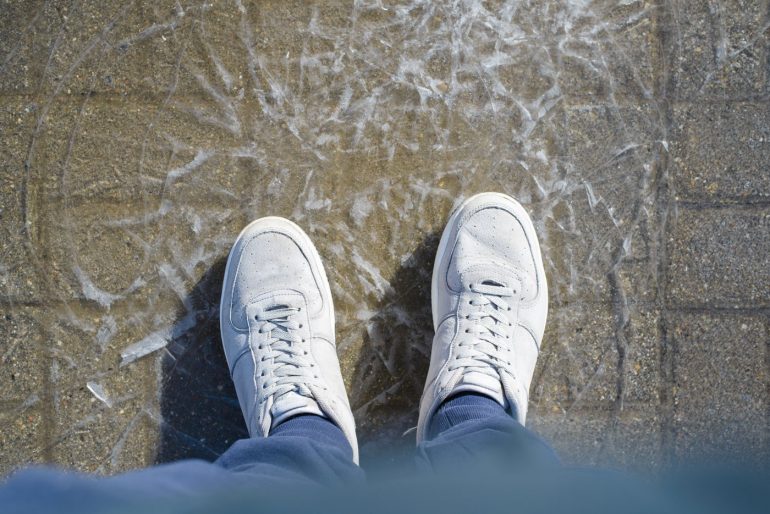Whenever much of the country in the grip of winter, the risk of falls is very real.
Snowy and icy conditions increase the number of sprains and fractures from falls, but there are things you can do to stay steady and upright when navigating winter sidewalks. So how can you stay safe walking on ice in the winter? Here are some tips.
Staying safe on the ice: Icy sidewalks
“It’s important that you arrive at your destination safely when walking in winter,” says Paul Peters, MD, an orthopedic foot and ankle specialist in Dayton, Ohio. “Proper footwear and awareness of where you’re stepping will help you avoid falls and injury.”
“We see a definite an increase in injuries, including fractures, which are breaks in the bone, resulting from slips and falls, or accidents involving motor vehicles during harsh weather conditions,” says Michael D Stover MD, an orthopedic surgeon at Northwestern Memorial Hospital and professor of orthopedic surgery at Northwestern University Feinberg School of Medicine.
“Broken ankles are also one of the most common fracture types, and can be caused by slipping and twisting the ankle while navigating slippery surfaces.”
According to Doctors Stover and Peters, as well as members of the American Orthopaedic Foot & Ankle Society (AOFAS), the following simple steps can reduce your risk of a fall and injury this winter.
How to walk safely on ice and snow
Wear footwear that provides traction. Soles should be made of a non-slip material such as rubber and offer grooves that will grip walking surfaces. Avoid wearing footwear with smooth soles or heels, as these will slide easily on slick sidewalks or pavement.
Don’t assume that athletic shoes (like sneakers), with their grooved soles, will keep you safe on icy streets. Cold-weather boots are your best bet.
Take your time! Be sure to give yourself extra time to get where you are going so that you do not have to rush. Dr Stover says to avoid running for buses, or trying to beat traffic when crossing a street. (Don’t worry — you can catch the next ride.)
Mindfully adjust your pace and gait when walking in icy areas, as described below.
Step carefully. Peters recommends you walk with shorter steps and bend your knees slightly so you can more easily maintain your balance.
Take small, cautious steps and stay low to the ground walking with curled toes and a flat foot, adds Dr Stover. You should feel like you’re shuffling rather than taking normal strides.

Wear the right footwear. Stover says to wear winter boots with good traction and avoid shoes with smooth, slippery bottoms. Go for function over fashion.
Dr Peters also suggests that you wear heavy socks to add insulation to your cold-weather boots. Change your socks if they become wet and you have to stay outside, because wet socks and dangerously low temperatures do not mix.
Brace yourself: When entering and exiting a vehicle, support yourself before standing and use the car or truck door for stability, says Stover. Likewise, when exiting a bus or other public transit, use the rails.
When out walking, watch for obvious patches of ice as well as “black ice,” an icy glaze that forms when moisture freezes. Black ice is particularly dangerous because you can be fooled into thinking it’s just a wet spot on the sidewalk. If you encounter a patch of ice or suspected black ice, step into snow or grass to gain traction and walk around that area.
Go hands-free: Your arms help you balance, so avoid heavy purses, coffee, or holding your phone out in front of you while walking on icy or snow-covered surfaces. If you have to take a photo or send a text, stop walking and move to the side so you’re away from the flow of other pedestrians.
Walking on ice: When a fall can’t be prevented
While not every fall can be avoided, Northwestern Medicine spine surgeon Alpesh Patel, MD, says there is a right way and wrong way to fall.
“On average, you have less than two seconds from the moment you lose your balance to the moment you hit the ground,” says Patel. “Knowing how to fall properly can save you from pain and injury.”
When a fall is imminent, staying calm and avoiding panic is important, because an injury is more likely to occur when muscles are tense.
If falling backward, try to fall into a sitting position which is the safest way to land. Protecting the head and skull should always be a priority if you fall, but be careful to not try to break a fall with your hands.
What to do if you hurt your foot or ankle
Sometimes slips are unavoidable even when you wear the right footwear and walk slowly. If you fall and hurt a foot or ankle, assess the injury as quickly as possible.
The AOFAS says you should see an orthopedic foot and ankle medical professional if you notice any of the following:
Pain that persists for more than 72 hours
Swelling of one leg or foot that persists for more than 24 hours
Pain that increases with exercise or walking
Pain at rest or with elevation of the legs
Loss of sensation
“When you have an injury, being evaluated and treated early can help lessen the pain and speed your recovery,” says Dr Peters. “Proper treatment of a sprain or fracture can also help avoid long-term problems such as chronic pain and instability.”








